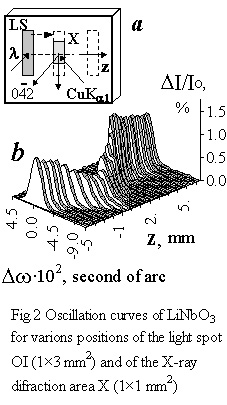 |
 |
INVESTIGATION OF EXTERNAL INHOMOGENEITY EFFECTS ON THE X-RAY AND OPTICAL PARAMETERS OF LiNbO3 AND SBN CRYSTAL
Andrey.A. Zholudev, Vladimir.N. Trushin, Yevgeny. V. Chuprunov, Mickael.A. Faddeyev, Aleksander.F. Khokhlov
Nizhny Novgorod State University, Physics Department, 23 Gagarin av., NiPTI office 343, Nizhny Novgorod, Russia, http://phys.unn.runnet.ru
Keywords:
X-ray Image, topogram, diffraction, optical, inhomogeneous
thermoinduced deformations, absorption
Local changes in X-ray diffraction parameters of LiNbO3 and SBN were studied in blackened diffracting crystals illuminated with spatially-modulated light (l) in a non-symmetrical Bragg setup. The structures of X-ray diffraction maxima (XDM) of X-ray images (XI) were fixed on a photographic plate as topograms (Fig.1a).
 |
 |
The spatial structure of the XI is generally inverse relative to the optical image (OI), but under certain conditions it can be in conformity with the OI (Fig.1b). The shape of the XI is attributed is attributed to local changes in the conditions of X-ray diffraction due to structural distortions caused by inhomogeneous thermoinduced deformations. The distribution of deformations is determined by the spatial and temporal structure of the OI.
In the homogeneously illuminated area on crystal surface, contrast variation on the topograms is determined by its deviation from the Bragg angle related to the area's temperature and fault structure as well as to the thermoelastic parameters of the crystal. At the "light and darkness" interface, areas with increased intensity of X-ray diffraction maxima are observed (contour effect). It is attributed to the fact that extinction attenuation of the intensity is reduced there. Fig.2 shows oscillation curves of LiNbO3 for different positions of the light spot (LS) relative to the diffraction area of X ray radiation (X). The value of intensity change (DI/I0) depends on crystal perfection. For example, in LiNbO3:Cu having a more faulty structure, the contour effect was absent. Similar phenomena were observed in SBN and some other crystals.
Inhomogeneous temperature deformations also lead to changes in crystal optical parameters. In LiNbO3 both an increase and a decrease in absorption coefficients were discovered that were related to the value and the direction of the temperature gradient, to the direction of the light beam and the optical axis of the crystal.